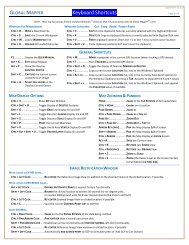Map GPS Coordinates - GPS Map Coordinates ... - Global Mapper
Map GPS Coordinates - GPS Map Coordinates ... - Global Mapper
Map GPS Coordinates - GPS Map Coordinates ... - Global Mapper
You also want an ePaper? Increase the reach of your titles
YUMPU automatically turns print PDFs into web optimized ePapers that Google loves.
<strong>Global</strong> <strong>Map</strong>per User's Manual<br />
data will be compressed using the PackBits compression algorithm.<br />
• 24-bit RGB - This option generates a raster GeoTIFF file with 24-bits per pixel. Uncompressed<br />
GeoTIFF images generated with this option will be at least 3 times the size of those generated with<br />
the 8-bit Palette option, but the colors in the image will exactly match what you see on the screen.<br />
You can also maintain the exact colors while achieving some compression using the LZW<br />
compression option. Selecting the JPEG compression option generates a raster GeoTIFF file with<br />
24-bits per pixel but with the raster data compressed using the JPG compression algorithm. GeoTIFF<br />
images generated with this option will maintain good color fidelity and often be highly compressed,<br />
although they will lose some information as compared to the uncompressed 24-bit RGB option.<br />
Something else to keep in mind if selecting this option is that many software packages do not yet<br />
support GeoTIFF files that use the JPEG-in-TIFF compression option. By default the JPG<br />
compression used in the GeoTIFF file uses a quality setting of 75, but you can modify this by creating<br />
a new DWORD registry key with the desired value at "HKEY_CURRENT_USER\Software\<strong>Global</strong><br />
<strong>Map</strong>per\JpegInTiffQuality".<br />
• Multi-band - This option generates a raster GeoTIFF file with 1 or more bands of data at either 8-,<br />
16-, or 32-bits per band of data. This option is very useful when working with multi-spectral imagery<br />
with more than 3 bands of data, like RGBI or Landsat imagery, or data sets with more than 8 bits per<br />
color channel. If you select this option, after hitting OK to start the dialog additional dialogs will be<br />
presented allowing you to further setup the multi-band export by choosing the input sources for each<br />
band in the output image.<br />
• Black and White- This option generates a two color GeoTIFF file with 1 bit per pixel. This will<br />
generate by far the smallest image, but if you source image had more than two colors the resulting<br />
image will be very poor. By default, white will be a value of 0 and black will be a value of 1, but you<br />
can reverse this by selecint the Grayscale - Min Is Black palette option.<br />
• Elevation (16-bit integer samples) - This option generates an elevation GeoTIFF using the currently<br />
loaded elevation grid data sets. Elevation samples will be stored as signed 16-bit integers. There are<br />
only a handful of software packages that can recognize a vertical GeoTIFF properly, so only use this<br />
if you know it works.<br />
• Elevation (32-bit floating pointr samples) - This option generates an elevation GeoTIFF using the<br />
currently loaded elevation grid data sets. Elevation samples will be stored as 32-bit floating point<br />
values. There are only a handful of software packages that can recognize a vertical GeoTIFF properly,<br />
so only use this if you know it works.<br />
When generating a 256 color (8-bits per pixel) GeoTIFF, it is necessary to select a palette indicates what 256<br />
colors will be used to describe the image being exported. The following choices of palette are available:<br />
• Image Optimized Palette - The palette generated will be an optimal mix of up to 256 colors that will<br />
closely represent the full blend of colors in the source images. This option will generate the best<br />
results, but can more than double the export time required if any high color images are present in the<br />
export set. If all of the input data is palette-based and the combined palette of those files has 256<br />
colors or less, then the combined files of the input file will just be used with no additional export time<br />
being required.<br />
• Grayscale Palette - This palette consists of 256 scales of gray ranging from black to white.<br />
• DRG Optimized Palette - This palette is optimized for the exporting USGS DRG data. The palette<br />
consists of only the standard DRG colors.<br />
• DRG/DOQ Optimized Palette - As the name suggests, this palette is optimized for exporting a mixture<br />
of USGS DRG data and grayscale satellite photos (i.e. USGS DOQs). The palette consists of the 14<br />
standard DRG colors with the remaining 242 colors being a range of gray values ranging from black<br />
to white.<br />
• Halftone Palette - The palette consists of a blend of 256 colors evenly covering the color spectrum.<br />
This palette is the best choice when exporting anything but DRGs and grayscale satellite photos.<br />
<strong>Map</strong> <strong>GPS</strong> <strong>Coordinates</strong> - <strong>GPS</strong> <strong>Map</strong> <strong>Coordinates</strong> - <strong>GPS</strong> <strong>Coordinates</strong> <strong>Map</strong> 33







